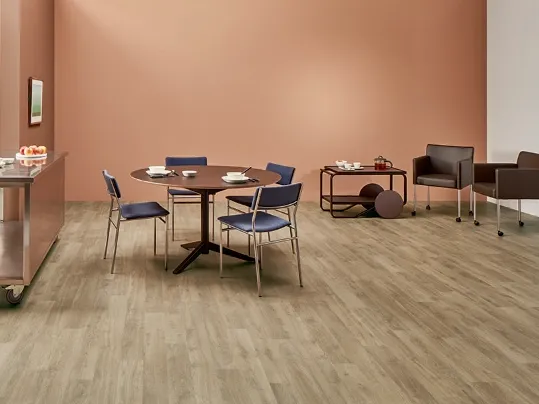Specifying Safety Flooring
Floored It Blog Series
April 2020

Today marks the World Day for Safety and Health at Work, an opportune moment to explore the topic of safety flooring – considering one third of all major workplace injuries are from slips and falls. Here we explain how to ensure you choose a sustainable and genuine safety flooring.
Slips and trips don’t just happen; there is always a common factor that plays a part in any accident, such as spillages, footwear and of course, the type of flooring. However, there are measures that can be taken to reduce slip risks and one of them is to ensure that you choose a genuine safety flooring for areas of a building where continuous contamination is expected, such as cooking oil and grease in commercial kitchens or excess water in bathrooms.
So, what is a safety flooring?
Whilst there is no formal definition of a safety floor, it has been widely accepted by the flooring industry for many years that safety floors are floor coverings that contain hard particles in their structure (not just on the surface) to provide enhanced slip resistance properties. And as the product wears in use, new particles within the structure are exposed, ensuring that the slip resistance of the floor covering is maintained throughout its service life; providing guaranteed sustainable slip resistance from the first to the last day of use.

There are many safety floorings available on the market, but it’s important that you choose a product that has slip resistance properties, which are sustainable throughout its lifecycle. Therefore, it’s beneficial to develop a clear understanding of the flooring test methods and what the results mean in terms of contributing to the prevention of slips and trips.
The Pendulum Test
The Pendulum Test is the test method recommended by the HSE to assess the slip resistance of floor surfaces. The test can assess slip resistance in both dry and contaminated conditions and measures the coefficient of friction of a floor surface to provide a slip potential classification. Pendulum testing is used for laboratory testing to provide ex-factory slip resistance values, on site to provide “as installed” test results, and as part of an investigation of incidents of slips. A pendulum test value (PTV) of 36 or higher is classified as low slip risk.
Ramp test ratings
Slip resistance performance based on ramp test ratings; “an R Value” is also often quoted. However, it is a common misconception that R10 floor coverings are extremely slip-resistant, with some people believing that the scale starts at R1, when in fact it starts at R9. Ramp test values are based on ex-factory testing and do not take account of changes in slip resistant properties that could occur during the working life of the floor covering. DIN51130 ramp test values should not, therefore, be considered in isolation.
EN13845:2017
EN13845:2017 is the European standard for PVC floor coverings with particle-based (e.g. carborundum, cork) enhanced slip resistance, commonly referred to as safety floors, and is another important factor to consider for the long-term slip resistance of flooring in use. The test methods referenced in this standard for determining slip resistance of floor coverings are wet tests, both barefoot and with footwear (shod), based on the Ramp test and the Pendulum test. Products can be classified as ESf (Enhanced Slip for use with footwear) or ESb (Enhanced Slip for barefoot use) to this standard (or both).
Whilst the performance classifications are also based on ex-factory testing, this standard includes a durability (abrasion) test to support claims of sustainable slip resistance throughout the life of the floor covering.
Our Step safety collection has guaranteed lifetime slip resistance performance and meets the requirements of EN13845:2017 class Esf and Esb, while also having wet pendulum test values of ≥ 36 to ≥ 50 and all of the relevant slip ratings (R10 to R12).
Consisting of 11 individual ranges and three different slip resistance levels, the collection offers true design freedom for contractors with endless possibilities to create safe environments without compromising on aesthetics. Containing innovative slip resistant particles, Step Crystals, this contributes to a fresh look and enhanced environmental performance, ideal for any application area.
